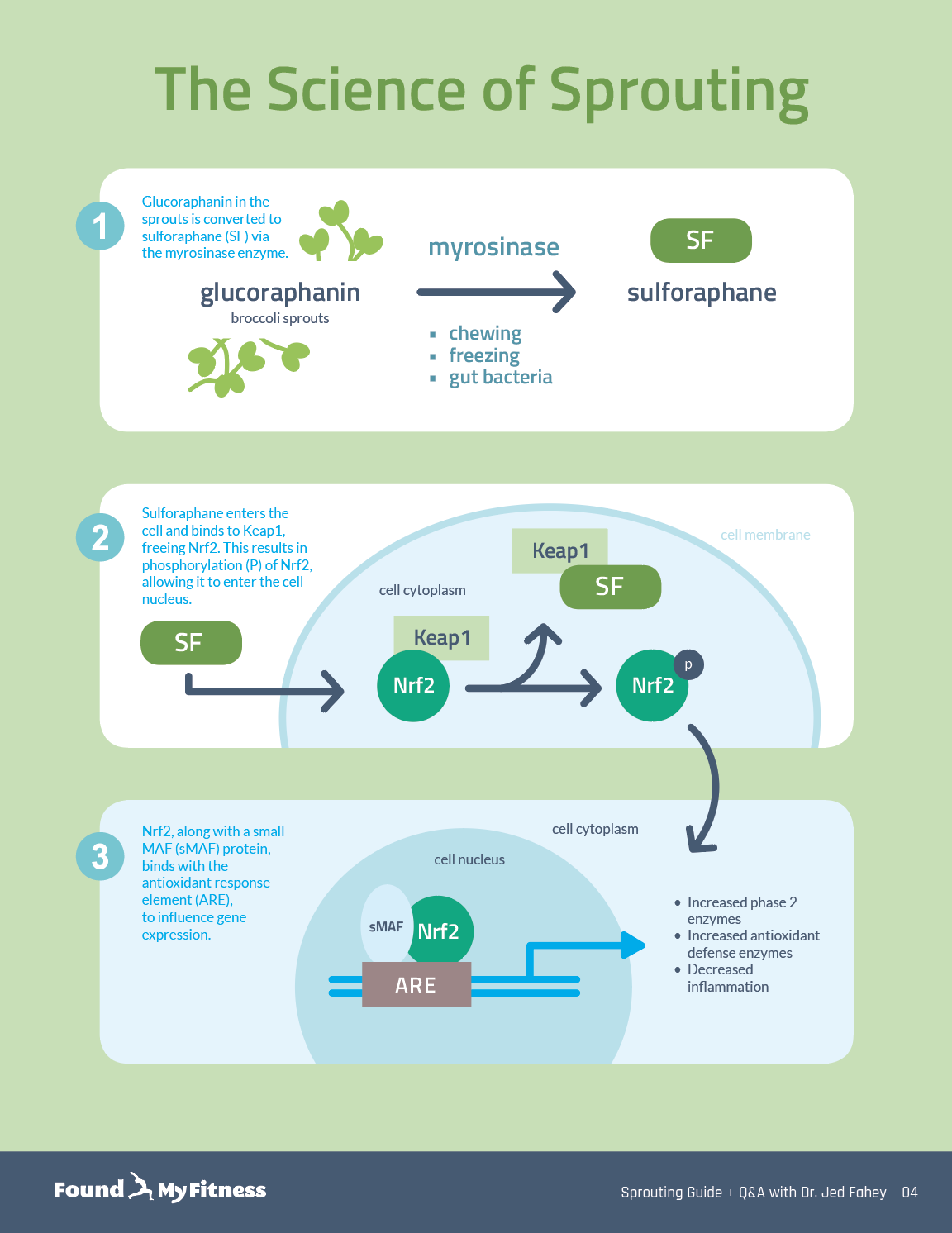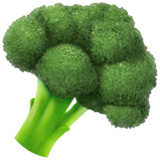Introduction to sulforaphane and its precursor glucoraphanin | Jed Fahey
Enter your email to get our 15-page guide to sprouting broccoli and learn about the science of chemoprotective compount sulforaphane.
Broccoli sprouts are concentrated sources of sulforaphane, a type of isothiocyanate. Damaging broccoli sprouts – when chewing, chopping, or freezing – triggers an enzymatic reaction in the tiny plants that produces sulforaphane.

Get the full length version of this episode as a podcast.
This episode will make a great companion for a long drive.
Sulforaphane, an isothiocyanate compound derived from cruciferous plants such as broccoli, cauliflower, and mustard, was discovered in 1992 by the late Dr. Paul Talalay and his then student, Dr. Yuesheng Zhang. Their early research in cell culture and rodent studies – and later in humans – showed that sulforaphane switches on cellular mechanisms that protect against cancer and other environmental insults in a hormetic-type response. That early research also revealed that sulforaphane is an artifact of isolation: It isn't present in the plants from which it is derived. Rather, it is produced when the plant is damaged when attacked by insects or eaten by humans. In this clip, Dr. Jed Fahey describes how sulforaphane was discovered, how it is produced in plants, and the mechanisms by which it produces health effects in humans.
Jed: Sulforaphane is a small molecule that was discovered in broccoli by Paul Talalay and Yuesheng Zhang, his student at the time, in 1992 or so. They published on it. And it was of interest in particular because it was a huge inducer of protective enzymes in people. Of course, it wasn't known that this occurred in people at the time, but in cell cultures and in animals, they showed that it up-regulated the protective enzymes, cytoprotective enzyme system known by some as the phase II enzyme system.
And, Paul then, who was one of the grandfathers of chemoprotection and has...it really helped make people stand up and pay attention to the fact that you could potentially prevent diseases like cancer. Paul asked me to join the group in 1993, and the challenge was, can you get broccoli with more sulforaphane? I came from a background in plant biotechnology, and, of course, I said, "Yes, we should be able to." And we started trying to breed and cross broccolis to get higher levels of sulforaphane.
Quickly, it became obvious that it was very difficult to predict how much sulforaphane a broccoli plant would have based on things like smell, touch, color and you pretty much had to run it through an HPLC to measure levels of sulforaphane. What's more is we realized that sulforaphane is not what's present in the intact plant. So what's present in the plant is something called glucoraphanin and that is a thioglucose conjugated molecule, not to get too heavily into the biochemistry of it, but it's a bigger molecule, it's a precursor and it's very stable. Sulforaphane is not at all stable. It's highly reactive. And so at any rate, it turned out that the intact broccoli plants had glucoraphanin at various levels ranged all over the map, couldn't figure out exactly how much one had without doing chemical analyses.
And we were going out to the field in the eastern shore of Maryland. And eventually, winter came along, and we couldn't go out to the fields and get broccoli anymore. So we started growing them in incubators in the labs starting from seeds. And lo and behold, it turns out that broccoli sprouts had much higher levels of the precursor of sulforaphane, glucoraphanin, than did the mature plants, the heads of broccoli that you buy in the market. So we then determined that if you grow broccoli sprouts all the same way, which you pretty much do if you are a home sprouter or a commercial sprouter, you add a certain amount of light, you add fresh water, you grow them for a certain amount of time at a certain temperature. So if you did that with a whole slew of different cultivars, that's the different sub-varieties of broccoli, you got a range of different activities, different amounts of glucoraphanin.
Anyway, bottom line is by selecting the appropriate genotypes, the appropriate broccoli genetics, if you will, we identified some varieties that had very high levels of glucoraphanin. Paul and I made a conscious decision at that time that we were going to promote the use of broccoli sprouts, not broccoli seeds. Because it turns out the seeds had the highest amount on a per gram basis of glucoraphanin. But at the time, no one had eaten broccoli seeds. You know, they weren't green. They didn't have the sort of cachet or the appearance of eating healthy green vegetables. So we focused on sprouts, which had much higher levels than the mature plants, although lower levels than the seeds.
And it turns out that then there is an enzyme that the plant tissue contains called myrosinase. And that enzyme converts glucoraphanin, the precursor, which is stored in vacuoles in the plant cells to sulforaphane. And typically in nature, the plant does that as a protective mechanism. If an insect starts chewing on the leaf of a broccoli plant, for example, it breaks open cells, right? And so those cells then release their glucoraphanin and the enzyme that's present at the same site hydrolyzes glucoraphanin and forms sulforaphane. And sulforaphane repels those bugs or is in some cases toxic to those bugs. So they go...and they fly away or they crawl away. But it turns out that sulforaphane is also a foreign compound for our cells. But in the process of being recognized and chucked out of the cell, if you will, it up-regulates the protective enzymes in those cells. And so that's why it's so special.
Rhonda: Like a hormetic effect, like a hormetic effect where...
Jed: Yeah. So clearly, if all you ate was sulforaphane, you'd be in trouble.
Rhonda: Yeah.
Jed: But the same with just about anything you can suggest. So it gears up or cranks up the protective mechanisms of the cells.
A group of plants of the same species that have been maintained through cultivation and selective breeding. Cultivars are usually designated in the style Taxus baccata “Variegata.”
Any of a group of complex proteins or conjugated proteins that are produced by living cells and act as catalyst in specific biochemical reactions.
The genetic constitution of an individual organism. The combination of genotype and environment determine an organism's physical characteristics – known as the phenotype.
A glucosinolate (see definition) found in certain cruciferous vegetables, including broccoli, Brussels sprouts, and mustard. Glucoraphanin is hydrolyzed by the enzyme myrosinase to produce sulforaphane, an isothiocyanate compound that has many beneficial health effects in humans.
Biological responses to low-dose exposures to toxins or other stressors such as exercise, heat, cold, fasting, and xenohormetics. Hormetic responses are generally favorable and elicit a wide array of protective mechanisms. Examples of xenohormetic substances include plant polyphenols – molecules that plants produce in response to stress. Some evidence suggests plant polyphenols may have longevity-conferring effects when consumed in the diet.
Byproduct of a reaction between two compounds (glucosinolates and myrosinase) that are found in cruciferous vegetables. Isothiocyanates inhibit phase I biotransformation enzymes, a class of enzymes that transform procarcinogens into their active carcinogenic state. Isothiocyanates activate phase II detoxification enzymes, a class of enzymes that play a protective role against DNA damage caused by reactive oxygen species and carcinogens. Examples of phase II enzymes include UDP-glucuronosyltransferases, sulfotransferases, N-acetyltransferases, glutathione S-transferases, and methyltransferases.
A class of proteins present in many edible plants, such as grains or legumes. Lectins are carbohydrate-binding molecules. They have been referred to as antinutrients for their ability to impair absorption of some nutrients. Many lectins possess hemagglutinin properties, which means they can bind to blood cells and cause them to aggregate. Cooking typically denatures lectins in foods.
A family of enzymes whose sole known substrates are glucosinolates. Myrosinase is located in specialized cells within the leaves, stems, and flowers of cruciferous plants. When the plant is damaged by insects or eaten by humans, the myrosinase is released and subsequently hydrolyzes nearby glucosinolate compounds to form isothiocyanates (see definition), which demonstrate many beneficial health effects in humans. Microbes in the human gut also produce myrosinase and can convert non-hydrolyzed glucosinolates to isothiocyanates.
An isothiocyanate compound derived from cruciferous vegetables such as broccoli, cauliflower, and mustard. Sulforaphane is produced when the plant is damaged when attacked by insects or eaten by humans. It activates cytoprotective mechanisms within cells in a hormetic-type response. Sulforaphane has demonstrated beneficial effects against several chronic health conditions, including autism, cancer, cardiovascular disease, diabetes, and others.
Get email updates with the latest curated healthspan research
Support our work

Every other week premium members receive a special edition newsletter that summarizes all of the latest healthspan research.
Sulforaphane News
- Sulforaphane extends lifespan and healthspan in worms via insulin and insulin-like growth factor-1 signaling.
- Paul Saladino, MD explains how we may have overstated the health benefits of plants and especially sulforaphane
- NRF2 much of a good thing (December 2017)
- A pilot trial finds sulforaphane treatment increased glutathione levels in the blood & hippocampus region of the brain in healthy people.
- A new study found sulforaphane (found in broccoli sprouts) improved behavior & social responsiveness in children with autism.





































































